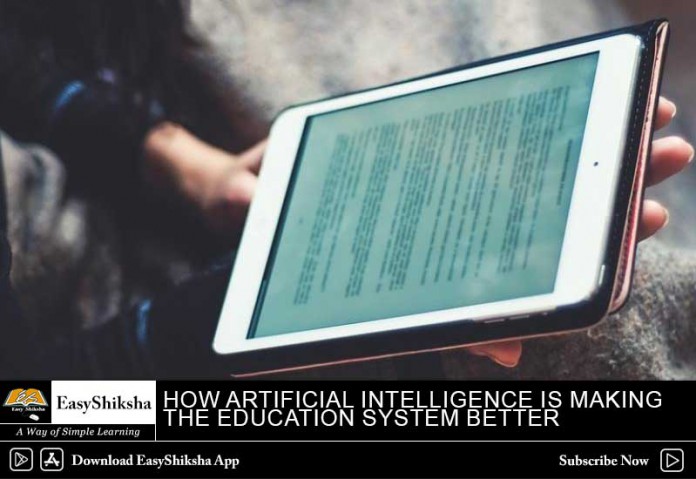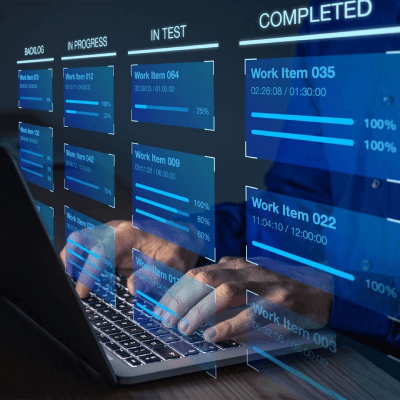If I told you artificial intelligence can make education better, what would you say? Artificial Intelligence (AI) is affecting numerous aspects of our lives. As we’ve noted previously, AI is present everywhere and the education sector is also experiencing changes because of AI. For example, updates to the use of educational systems that include more personalisation as well as reduced time wasted for teachers and administrators. Artificial Intelligence What’s more, new platforms and new opportunities can be expanded upon to create systems of scale for educational institutions globally.

Important Announcement – EasyShiksha has now started Online Internship Program “Ab India Sikhega Ghar Se”

AI is taking centre stage in the educational sector, and we’re glad to see it. In fact, we think it’s upending traditional problems faced by the education system.
How, exactly? AI is being used to help students not just find the right study material but also to assist them with finding solutions to their most pressing challenges. AI is being deeply integrated in the curriculum database to expand the horizons of teaching. Technology does not limit itself to being a mere teacher. It is taking the role of an evaluator.
Of the numerous ways artificial intelligence will adjust the education sector for the better, 10 are outlined below.
1. Enhanced teacher-AI collaboration: Physical, human teachers see certain limitations, namely there is no scalable way for students to participate with teachers. This leads to gaps between the lessons teachers submit to their administrators and the principles students understand. With better use of AI (as well as VR and other technologies), participation can become more scalable to allow engagement between classes of all sizes and teachers who have more time to focus on making their subjects as fun and interesting as they are engaging for their pupils.
2. Individualized learning: Since learning styles differ from child to child, personalised learning can assist those children who face challenges learning (like those children with ADHD, autism or dyslexia). While it’s not manually possible for a teacher to cater to every child’s ability in a class of 30 students, AI can. And it can help kids experiment to find which is the best way they can learn new skills–all in a scalable way. To this end, schools, colleges and universities can use AI to design curriculum, test and feedback to students on all levels.
3. Making education accessible to all: AI-enabled tools make classrooms available to all despite language, location or physical impairment. This helps such students in pursuing education who might not be able to undertake education otherwise for variety of reasons. How? Think about a student who can take classes virtually because they’ve been in the hospital for 8 weeks. Or the child who’s family travels frequently–she could attend classes no matter where she is in the world.
4. Automating admin job: A teacher spends hours weekly–even daily–in assigning and assessing homework and tests. With the help of AI, this task could be done faster and easier for teachers, who often take their students assignments home to grade them. This allows more time to teachers to invest in each student or other activities that engage the classroom.
5. Automated grading: Grading can be a difficult, and sometimes burdening, process for teachers. Instead, AI-based computer programs can replicate a teacher’s behaviour to assign grades to students’ tests. This standardizes assessing every child’s knowledge and keeps the teacher available to do other more pressing work. Thereafter, feedback on performance and the plan.
6. Virtual teachers: Although it’s happening slowly, some universities are introducing virtual teachers and faculty who are useful in helping students who may not be available in classrooms all the time.
Top Courses in Software Engineering
7. Chat campus: International universities are using AI to design systems that could help students on the campus in various ways. The AI-enabled program or a chatbot called chat campus would be answering questions about the campus. For example, where will the next class take place or what are the details on the next assignment? These free up time from both teachers as well as administrators to do more pressing tasks.
8. Adaptive learning: This is assumed to be one of the most crucial areas where AI could be beneficial in educational settings. With the help of AI, schools could be enabled to keep track of the progress of each student and make alterations in the course and update the teacher about the challenges that every student faces.
9. Better institutional management: With a growing number of schools across the globe, there is an increasing interest in school management platforms for educational administrators. AI helps create such platforms which can assist institutions with recruitment, student information and fee collection, just to name a few points.
10. Safety and security: For any educational institution, it’s crucial to keep violence and bullying in check. Thankfully, with the help of AI, spotting patterns in a student’s behaviour or conduct to gauge violence in the school is made easy. Students who are consistently violent towards others can be handled with more humanity, but can also be better tracked to ensure their pattern of violence is stopped.
AI in education has the opportunity to improve quality time between teacher and student. AI can overall improve the system for students, teachers and administrators. Though certainly, there should be consideration into the execution of these systems of AI, their development and utilization can add value to institutions of education worldwide.
Empower your team. Lead the industry
Get a subscription to a library of online courses and digital learning tools for your organization with EasyShiksha
Request NowQ. Are EasyShiksha's internships truly free?
Yes, all internships offered by EasyShiksha are completely free of charge.
Q. How can I apply for an internship with EasyShiksha?
You can apply by visiting our website, browsing available internships, and following the application instructions provided.
Q. What types of internships are available through EasyShiksha?
EasyShiksha offers a wide range of internships across technology, business, marketing, healthcare, and more. Opportunities are continuously updated.
Q. Will I receive a certificate upon completing an internship?
Yes, upon successful completion, you will receive a certificate recognizing your participation and achievements.
Q. Are EasyShiksha's internship certificates recognized by universities and employers?
Yes, the certificates are recognized by universities, colleges, and employers worldwide.
Q. Is the download of certificates free or paid?
Access to internships and courses is free, but there is a small fee to download certificates, covering administrative costs.
Q. When can I start the course?
You can choose any course and start immediately without delay.
Q. What are the course and session timings?
These are fully online courses. You can learn at any time and pace. We recommend following a routine, but it depends on your schedule.
Q. What will happen when my course is over?
After completion, you will have lifetime access to the course for future reference.
Q. Can I download the notes and study material?
Yes, you can access and download course materials and have lifetime access for future reference.
Q. What software/tools would be needed for the course?
All necessary software/tools will be shared during the training as needed.
Q. I’m unable to make a payment. What should I do?
Try using a different card or account. If the problem persists, email us at info@easyshiksha.com.
Q. Do I get the certificate in hard copy?
No, only a soft copy is provided, which can be downloaded and printed if required.
Q. The payment got deducted but shows “failed”. What to do?
Technical errors may cause this. The deducted amount will be returned to your account in 7-10 working days.
Q. Payment was successful but dashboard shows ‘Buy Now’?
Sometimes payment reflection is delayed. If it takes longer than 30 minutes, email info@easyshiksha.com with the payment screenshot.
Q. What is the refund policy?
If you face technical issues, you can request a refund. No refunds are issued once the certificate has been generated.
Q. Can I enroll in a single course?
Yes, select the course of interest, fill in the details, make payment, and start learning. You will also earn a certificate.
Q. My questions are not listed above. I need further help.
Contact us at info@easyshiksha.com for further assistance.
ALSO READ: Cricket-world-cup-points-table-team-ranking
Get Course: Google-Adwords-for-Beginners









































































